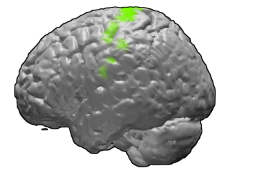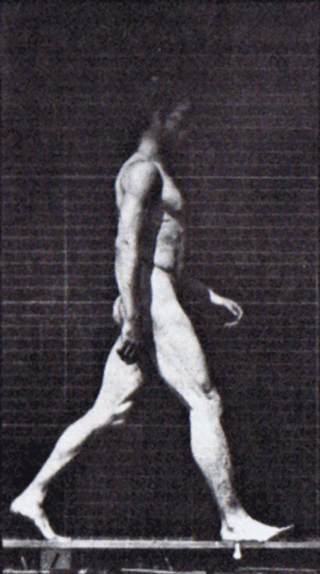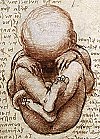
The cerebellum is a major feature of the hindbrain of all vertebrates. Although usually smaller than the cerebrum, in some animals such as the mormyrid fishes it may be as large as it or even larger. In humans, the cerebellum plays an important role in motor control. It may also be involved in some cognitive functions such as attention and language as well as emotional control such as regulating fear and pleasure responses, but its movement-related functions are the most solidly established. The human cerebellum does not initiate movement, but contributes to coordination, precision, and accurate timing: it receives input from sensory systems of the spinal cord and from other parts of the brain, and integrates these inputs to fine-tune motor activity. Cerebellar damage produces disorders in fine movement, equilibrium, posture, and motor learning in humans.
Motor learning refers broadly to changes in an organism's movements that reflect changes in the structure and function of the nervous system. Motor learning occurs over varying timescales and degrees of complexity: humans learn to walk or talk over the course of years, but continue to adjust to changes in height, weight, strength etc. over their lifetimes. Motor learning enables animals to gain new skills, and improves the smoothness and accuracy of movements, in some cases by calibrating simple movements like reflexes. Motor learning research often considers variables that contribute to motor program formation, sensitivity of error-detection processes, and strength of movement schemas. Motor learning is "relatively permanent", as the capability to respond appropriately is acquired and retained. Temporary gains in performance during practice or in response to some perturbation are often termed motor adaptation, a transient form of learning. Neuroscience research on motor learning is concerned with which parts of the brain and spinal cord represent movements and motor programs and how the nervous system processes feedback to change the connectivity and synaptic strengths. At the behavioral level, research focuses on the design and effect of the main components driving motor learning, i.e. the structure of practice and the feedback. The timing and organization of practice can influence information retention, e.g. how tasks can be subdivided and practiced, and the precise form of feedback can influence preparation, anticipation, and guidance of movement.
Muscle memory is a form of procedural memory that does involves consolidating a specific motor task into memory through repetition, which has been used synonymously with motor learning. When a movement is repeated over time, the brain creates a long-term muscle memory for that task, eventually allowing it to be performed with little to no conscious effort. This process decreases the need for attention and creates maximum efficiency within the motor and memory systems. Muscle memory is found in many everyday activities that become automatic and improve with practice, such as riding bikes, driving motor vehicles, playing ball sports, typing on keyboards, entering PINs, playing musical instruments, poker, martial arts, swimming, dancing, and drawing.
Kinesthetic learning, kinaesthetic learning, or tactile learning is learning that involves physical activity. As cited by Favre (2009), Dunn and Dunn define kinesthetic learners as students who prefer whole-body movement to process new and difficult information. However, scientific studies do not support the claim that using kinesthetic modality improves learning in students identified as kinesthetic learning as their preferred learning style.

The motor cortex is the region of the cerebral cortex involved in the planning, control, and execution of voluntary movements. The motor cortex is an area of the frontal lobe located in the posterior precentral gyrus immediately anterior to the central sulcus.
Focal dystonia, also called focal task-specific dystonia, is a neurological condition that affects a muscle or group of muscles in a specific part of the body during specific activities, causing involuntary muscular contractions and abnormal postures. There are many different types of focal dystonia, each affecting a different region of the body. For example, in focal hand dystonia, or writer's cramp, the fingers either curl into the palm or extend outward without control. In musicians, the condition is called musician's focal dystonia, or simply, musician's dystonia. In sports, it may be involved in what is commonly referred to as the yips. The condition appears to be associated with over-training, and individualized treatment strategies may involve medications, retraining techniques, and procedures.
Motor control is the regulation of movements in organisms that possess a nervous system. Motor control includes conscious voluntary movements, subconscious muscle memory and involuntary reflexes, as well as instinctual taxis.
In physiology, motor coordination is the orchestrated movement of multiple body parts as required to accomplish intended actions, like walking. This coordination is achieved by adjusting kinematic and kinetic parameters associated with each body part involved in the intended movement. The modifications of these parameters typically relies on sensory feedback from one or more sensory modalities, such as proprioception and vision.

Gross motor skills are the abilities usually acquired during childhood as part of a child's motor learning. By the time they reach two years of age, almost all children are able to stand up, walk and run, walk up stairs, etc. These skills are built upon, improved and better controlled throughout early childhood, and continue in refinement throughout most of the individual's years of development into adulthood. These gross movements come from large muscle groups and whole body movement. These skills develop in a head-to-toe order. The children will typically learn head control, trunk stability, and then standing up and walking. It is shown that children exposed to outdoor play time activities will develop better gross motor skills.
Premovement neuronal activity in neurophysiological literature refers to neuronal modulations that alter the rate at which neurons fire before a subject produces movement. Through experimentation with multiple animals, predominantly monkeys, it has been shown that several regions of the brain are particularly active and involved in initiation and preparation of movement. Two specific membrane potentials, the bereitschaftspotential, or the BP, and contingent negative variation, or the CNV, play a pivotal role in premovement neuronal activity. Both have been shown to be directly involved in planning and initiating movement. Multiple factors are involved with premovement neuronal activity including motor preparation, inhibition of motor response, programming of the target of movement, closed-looped and open-looped tasks, instructed delay periods, short-lead and long-lead changes, and mirror motor neurons.
Psychomotor learning is the relationship between cognitive functions and physical movement. Psychomotor learning is demonstrated by physical skills such as movement, coordination, manipulation, dexterity, grace, strength, speed—actions which demonstrate the fine or gross motor skills, such as use of precision instruments or tools, and walking. Sports and dance are the richest realms of gross psychomotor skills.
Procedural memory is a type of implicit memory which aids the performance of particular types of tasks without conscious awareness of these previous experiences.

The primary motor cortex is a brain region that in humans is located in the dorsal portion of the frontal lobe. It is the primary region of the motor system and works in association with other motor areas including premotor cortex, the supplementary motor area, posterior parietal cortex, and several subcortical brain regions, to plan and execute voluntary movements. Primary motor cortex is defined anatomically as the region of cortex that contains large neurons known as Betz cells, which, along with other cortical neurons, send long axons down the spinal cord to synapse onto the interneuron circuitry of the spinal cord and also directly onto the alpha motor neurons in the spinal cord which connect to the muscles.
The neuroscience of music is the scientific study of brain-based mechanisms involved in the cognitive processes underlying music. These behaviours include music listening, performing, composing, reading, writing, and ancillary activities. It also is increasingly concerned with the brain basis for musical aesthetics and musical emotion. Scientists working in this field may have training in cognitive neuroscience, neurology, neuroanatomy, psychology, music theory, computer science, and other relevant fields.
Fine motor skill is the coordination of small muscles in movement with the eyes, hands and fingers. The complex levels of manual dexterity that humans exhibit can be related to the nervous system. Fine motor skills aid in the growth of intelligence and develop continuously throughout the stages of human development.
In neuroscience and motor control, the degrees of freedom problem or motor equivalence problem states that there are multiple ways for humans or animals to perform a movement in order to achieve the same goal. In other words, under normal circumstances, no simple one-to-one correspondence exists between a motor problem and a motor solution to the problem. The motor equivalence problem was first formulated by the Russian neurophysiologist Nikolai Bernstein: "It is clear that the basic difficulties for co-ordination consist precisely in the extreme abundance of degrees of freedom, with which the [nervous] centre is not at first in a position to deal."
The neuroscience of rhythm refers to the various forms of rhythm generated by the central nervous system (CNS). Nerve cells, also known as neurons in the human brain are capable of firing in specific patterns which cause oscillations. The brain possesses many different types of oscillators with different periods. Oscillators are simultaneously outputting frequencies from .02 Hz to 600 Hz. It is now well known that a computer is capable of running thousands of processes with just one high-frequency clock. Humans have many different clocks as a result of evolution. Prior organisms had no need for a fast-responding oscillator. This multi-clock system permits quick response to constantly changing sensory input while still maintaining the autonomic processes that sustain life. This method modulates and controls a great deal of bodily functions.

Neuromechanics is an interdisciplinary field that combines biomechanics and neuroscience to understand how the nervous system interacts with the skeletal and muscular systems to enable animals to move. In a motor task, like reaching for an object, neural commands are sent to motor neurons to activate a set of muscles, called muscle synergies. Given which muscles are activated and how they are connected to the skeleton, there will be a corresponding and specific movement of the body. In addition to participating in reflexes, neuromechanical process may also be shaped through motor adaptation and learning.
The bi-directional hypothesis of language and action proposes that the sensorimotor and language comprehension areas of the brain exert reciprocal influence over one another. This hypothesis argues that areas of the brain involved in movement and sensation, as well as movement itself, influence cognitive processes such as language comprehension. In addition, the reverse effect is argued, where it is proposed that language comprehension influences movement and sensation. Proponents of the bi-directional hypothesis of language and action conduct and interpret linguistic, cognitive, and movement studies within the framework of embodied cognition and embodied language processing. Embodied language developed from embodied cognition, and proposes that sensorimotor systems are not only involved in the comprehension of language, but that they are necessary for understanding the semantic meaning of words.

Interlimb coordination is the coordination of the left and right limbs. It could be classified into two types of action: bimanual coordination and hands or feet coordination. Such coordination involves various parts of the nervous system and requires a sensory feedback mechanism for the neural control of the limbs. A model can be used to visualize the basic features, the control centre of locomotor movements, and the neural control of interlimb coordination. This coordination mechanism can be altered and adapted for better performance during locomotion in adults and for the development of motor skills in infants. The adaptive feature of interlimb coordination can also be applied to the treatment for CNS damage from stroke and the Parkinson's disease in the future.






